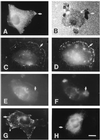Transmembrane/cytoplasmic domain-mediated membrane type 1-matrix metalloprotease docking to invadopodia is required for cell invasion
- PMID: 9223295
- PMCID: PMC21537
- DOI: 10.1073/pnas.94.15.7959
Transmembrane/cytoplasmic domain-mediated membrane type 1-matrix metalloprotease docking to invadopodia is required for cell invasion
Abstract
The invasion of human malignant melanoma cells into the extracellular matrix (ECM) involves the accumulation of proteases at sites of ECM degradation where activation of matrix metalloproteases (MMP) occurs. Here, we show that when membrane type 1 MMP (MT-MMP) was overexpressed in RPMI7951 human melanoma cells, the cells made contact with the ECM, activated soluble and ECM-bound MMP-2, and degraded and invaded the ECM. Further experiments demonstrated the importance of localization of the MT-MMP to invadopodia. Overexpression of MT-MMP without invadopodial localization caused activation of soluble MMP-2, but did not facilitate ECM degradation or cell invasiveness. Up-regulation of endogenous MT-MMP with concanavalin A caused activation of MMP-2. However, concanavalin A treatment prevented invadopodial localization of MT-MMP and ECM degradation. Neither a truncated MT-MMP mutant lacking transmembrane (TM) and cytoplasmic domains (DeltaTMMT-MMP), nor a chimeric MT-MMP containing the interleukin 2 receptor alpha chain (IL-2R) TM and cytoplasmic domains (DeltaTMMT-MMP/TMIL-2R) were localized to invadopodia or exhibited ECM degradation. Furthermore, a chimera of the TM/cytoplasmic domain of MT-MMP (TMMT-MMP) with tissue inhibitor of MMP 1 (TIMP-1/TMMT-MMP) directed the TIMP-1 molecule to invadopodia. Thus, the MT-MMP TM/cytoplasmic domain mediates the spatial organization of MT-MMP into invadopodia and subsequent degradation of the ECM.
Figures




Similar articles
-
Specialized surface protrusions of invasive cells, invadopodia and lamellipodia, have differential MT1-MMP, MMP-2, and TIMP-2 localization.Ann N Y Acad Sci. 1999 Jun 30;878:361-71. doi: 10.1111/j.1749-6632.1999.tb07695.x. Ann N Y Acad Sci. 1999. PMID: 10415741 Review.
-
CDCP1 regulates the function of MT1-MMP and invadopodia-mediated invasion of cancer cells.Mol Cancer Res. 2013 Jun;11(6):628-37. doi: 10.1158/1541-7786.MCR-12-0544. Epub 2013 Feb 25. Mol Cancer Res. 2013. PMID: 23439492
-
MMP Secretion Rate and Inter-invadopodia Spacing Collectively Govern Cancer Invasiveness.Biophys J. 2018 Feb 6;114(3):650-662. doi: 10.1016/j.bpj.2017.11.3777. Biophys J. 2018. PMID: 29414711 Free PMC article.
-
Protease activity at invadopodial focal digestive areas is dependent on NHE1-driven acidic pHe.Oncol Rep. 2014 Feb;31(2):940-6. doi: 10.3892/or.2013.2923. Epub 2013 Dec 13. Oncol Rep. 2014. PMID: 24337203
-
Membrane-type matrix metalloproteinases (MT-MMPs): expression and function during glioma invasion.J Neurooncol. 2001 Jun;53(2):187-202. doi: 10.1023/a:1012213604731. J Neurooncol. 2001. PMID: 11716070 Review.
Cited by
-
Transforming growth factor beta induces rosettes of podosomes in primary aortic endothelial cells.Mol Cell Biol. 2006 May;26(9):3582-94. doi: 10.1128/MCB.26.9.3582-3594.2006. Mol Cell Biol. 2006. PMID: 16611998 Free PMC article.
-
Melanoma Mediated Disruption of Brain Endothelial Barrier Integrity Is Not Prevented by the Inhibition of Matrix Metalloproteinases and Proteases.Biosensors (Basel). 2022 Aug 19;12(8):660. doi: 10.3390/bios12080660. Biosensors (Basel). 2022. PMID: 36005056 Free PMC article.
-
Mapping proteolytic cancer cell-extracellular matrix interfaces.Clin Exp Metastasis. 2009;26(4):289-98. doi: 10.1007/s10585-008-9190-2. Epub 2008 Jul 4. Clin Exp Metastasis. 2009. PMID: 18600304 Review.
-
ARF1 regulates the Rho/MLC pathway to control EGF-dependent breast cancer cell invasion.Mol Biol Cell. 2014 Jan;25(1):17-29. doi: 10.1091/mbc.E13-06-0335. Epub 2013 Nov 6. Mol Biol Cell. 2014. PMID: 24196838 Free PMC article.
-
Proteolytic processing of membrane-type-1 matrix metalloproteinase is associated with gelatinase A activation at the cell surface.Biochem J. 1998 Sep 1;334 ( Pt 2)(Pt 2):345-53. doi: 10.1042/bj3340345. Biochem J. 1998. PMID: 9716492 Free PMC article.
References
-
- Mignatti P, Rifkin D B. Physiol Rev. 1993;73:161–195. - PubMed
-
- Stetler-Stevenson W G, Aznavoorian S, Liotta L A. Annu Rev Cell Biol. 1993;9:541–573. - PubMed
-
- Chen W-T, Lee C C, Goldstein L, Bernier S, Liu C H, Lin C Y, Yeh Y, Monsky W L, Kelly T, Dai M, Mueller S C. Breast Cancer Res Treat. 1994;31:217–226. - PubMed
-
- Cockett M I, Birch M L, Murphy G, Hart I R, Docherty A J P. Biochem Soc Trans. 1994;22:55–57. - PubMed
-
- Birkedal-Hansen H, Moore W G I, Bodden M K, Windsor L J, Birkedal-Hansen B, DeCarlo A, Engler J A. Crit Rev Oral Biol Med. 1993;4:197–250. - PubMed
Publication types
MeSH terms
Substances
Grants and funding
LinkOut - more resources
Full Text Sources
Other Literature Sources
Medical
Research Materials
Miscellaneous

